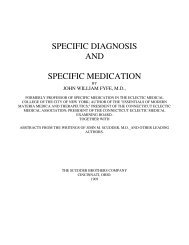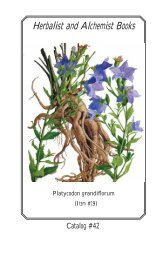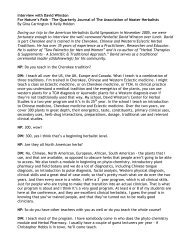MEDlCINAL PLANTS OF JAMAICA. PARTS 1 & 11.
MEDlCINAL PLANTS OF JAMAICA. PARTS 1 & 11.
MEDlCINAL PLANTS OF JAMAICA. PARTS 1 & 11.
Create successful ePaper yourself
Turn your PDF publications into a flip-book with our unique Google optimized e-Paper software.
More recently these practices appear to have been discontinued but Beckwith reported its use, alone or with<br />
laundry blue, as an application for boils. In Africa it is used for intestinal troubles in children, colic, dropsy and<br />
to promote sneezing. The tops are said to contain a glycoside asclepiadin and the roots vincetoxin. (2, 5, 8, 14,<br />
15, 24, 27).<br />
ASCLEPIAS NIVEA L. White Head.<br />
Used similarly to the preceding species and Beckwith records that the juice of this species, squeezed<br />
through a clean cloth, provides a worm remedy. (2).<br />
FUNASTRUM CLAUSUM (Jacq.) Schleder. Milk Wys (Withe).<br />
Used in decoction as a general beverage for adults and children, and as a cold remedy.<br />
BIGNONIACEAE<br />
A family of some five hundred mostly woody tropical plants of which the chemistry is little<br />
known.<br />
CRESCENTIA CUJETE L. Calabash.<br />
For coughs, colds and 'to clean out the womb' young fruits are roasted, the juice squeezed out and taken<br />
with castor oil. 'The fruit pulp is well known, if not too well known, to force the menses, birth and after-birth,<br />
(Barham). Beckwith gives a complex recipe for a cough syrup: 'Roast nine young calabashes, strain, add one<br />
pound sugar, five sweetsop leaves, five chigger nut leaves. Boil in thick, add a pint of wine and a "quattie"<br />
proof rum. Take a wine-glassful three times a day. The fruit pulp is also considered purgative (used with castor<br />
oil) and of use as a poultice. It is said to contain crescentic acid and chlorogenic acid. (2, 5, 14, 1 5, 24, 26, 27).<br />
BORAGINACEAE<br />
A family of about one thousand five hundred and fifty species of herbaceous and woody plants of<br />
temperate to tropical regions in which occur alkaloids, glycosides, tannins and pigments. Among the glycosides<br />
is consolidin and the alkaloids include cynoglossin and allantoin. Hound's-tongue, alkanet, borage and lungwort<br />
are members of this family.<br />
CORDIA GLOBOSA H.B.K. Black Sage; John Charles; Gout Tea.<br />
This species is used in Jamaica to prepare a tea as a general beverage and for colds and<br />
tightness in the chest'. In the Grenadines, where it is called man black sage, the leaves are<br />
similarly used to make tea for colds. (13, 25).<br />
HELIOTROPIUM PARVIFLORUM L. Wild Clary; Dog's Tail: Sage.<br />
Used to make tea for colds, 'for the belly', and as a wash for sore eyes. It may also be used as a general<br />
beverage. In Lagos H. indicum L. has similar uses. (25).<br />
TOURNEFORTIA HIRSUTISSIMA L. Chiqqer Nut; Crocus Bush: ?Hog Hook.<br />
Used both internally and externally in the treatment of colds, coughs and fever. Both leaves and stems<br />
are used to make the decoction. A bath containing this plant is also used after childbirth as also is the tea 'to<br />
clear the system'. Beckwith says that for coughs it is used in conjunction with sweetsop and young calabashes,<br />
while for 'gentleman's complaint' it is used with wild sage (?) and a dose of salts. (2, 25).<br />
CACTACEAE<br />
A family of about one thousand five hundred mostly succulent species mainly of tropical and subtropical<br />
America. They contain a series of characteristic alkaloids.







